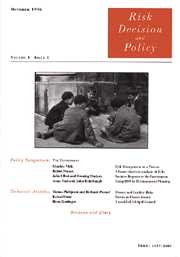Article contents
Coastal bathing water health risks: developing means of assessing the adequacy of proposals to amend the 1976 EC directive
Published online by Cambridge University Press: 01 April 2000
Abstract
Everyone likes clean seawater to bathe in and standards for acceptable seawater quality are set by the European Commission (CEC, 1976). In 1994, proposals to revise these standards were announced. These proposals were the subject of a House of Lords Select Committee Inquiry (HMSO, 1994, 1995), which deplored the fact that a soundly based cost–benefit analysis of the proposed revision had not been produced. This paper considers the question of developing means to assess the adequacy of the proposed revision from a social/public perception standpoint, using a mixed methodology of quantitative survey and qualitative focus groups. The aim of using such an approach is to provide a more in-depth and informative input into the decision-making process for policy makers. Our results show that mean willingness-to-pay amounts, representing the economic benefits of the revision to the 1976 EC bathing water standard, are roughly of the same order of magnitude as the estimated potential cost increases in average annual household water bills necessary to implement the revision. This result is qualified by analysis of how preferences are constructed in terms of socioeconomic variables, perceptions and attitudes towards risk, and issues such as trust, blame and accountability of institutions and regulatory processes involved in setting standards for bathing water quality.
- Type
- Technical article
- Information
- Copyright
- © Cambridge University Press, 2000
- 14
- Cited by




